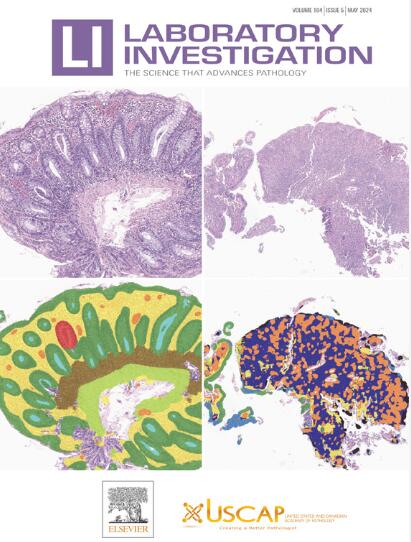Maturation-Related and Functional-Associated Phenotypic Profile of Tumor T Cells in Mature/Peripheral T-Cell Neoplasms: Association With the Diagnostic Subtype of the Disease
IF 5.1
2区 医学
Q1 MEDICINE, RESEARCH & EXPERIMENTAL
引用次数: 0
Abstract
T-cell chronic lymphoproliferative disorders (T-CLPD) are a heterogeneous group of mature T-cell malignancies, the classification of which remains challenging. In this study, we classified tumor cells from 86 patients diagnosed with either T-CLPD (n = 81) or T-cell acute lymphoblastic leukemia (n = 5) into precise functional and maturation-associated compartments, based on their phenotypic similarities with their normal maturation-related and functional associated T-cell counterparts. A database was generated using blood samples from 6 sex- and age-matched healthy donors as a template for normal T-cell subset flow cytometric immunophenotypes, to which tumor cells of individual patients were compared. Except for nodal T follicular–helper cell lymphoma and adult T-cell leukemia/lymphoma, which showed phenotypes overlapping with that of T follicular–helper and T regulatory cells, respectively, all other T-CLPD displayed immunophenotypic profiles consistent with conventional T helper (Th) cells, with different maturation-associated profiles per diagnostic category. These included predominant naive/naive-central memory phenotypes in T-cell prolymphocytic leukemia to terminal effector cytotoxic cellular profiles in T-cell large granular lymphocytic leukemia; other T-CLPD diagnostic categories (mostly Sézary syndrome/mycosis fungoides) resembled the diverse memory T-cell subsets. Interestingly, immunophenotypically less-mature tumor cells (T-cell prolymphocytic leukemia) displayed more heterogeneous Th profiles, whereas those with memory T-cell profiles showed more consistent Th-associated patterns (eg, Th2 or Th17 in Sézary syndrome/mycosis fungoides), and the most mature neoplasms (eg, T-cell large granular lymphocytic leukemia) systematically displayed a Th1-like pattern, reflecting progressively lower plasticity for the more advanced tumor-associated maturation stages. These findings confirm the presence of distinct phenotypic patterns resembling specific maturation-associated and Th-related profiles of normal T cells among distinct diagnostic categories of T-CLPD, which might contribute to a more precise classification of T-CLPD.
成熟/外周t细胞肿瘤中肿瘤t细胞的成熟相关和功能相关表型特征:与疾病的诊断亚型相关
t细胞慢性淋巴细胞增生性疾病(T-CLPD)是一种异质性的成熟t细胞恶性肿瘤,其分类仍然具有挑战性。在这里,我们将来自86名诊断为T-CLPD (n=81)或t急性淋巴细胞白血病(n=5)的患者的肿瘤细胞根据其与正常成熟相关和功能相关的t细胞的表型相似性,精确地分为功能和成熟相关的区室。使用来自6名性别和年龄匹配的健康供者的血液样本作为正常t细胞亚群流式细胞免疫表型的模板,生成数据库,并将个体患者的肿瘤细胞与之进行比较。除了结节T-滤泡辅助(TFH)细胞淋巴瘤和成人T细胞白血病/淋巴瘤(ATLL)分别显示与TFH和T调节细胞重叠的表型外,所有其他T- clpd显示与传统T辅助(h)细胞一致的免疫表型谱,每个诊断类别具有不同的成熟相关谱。这些包括t -原淋巴细胞白血病(T-PLL)中主要的幼稚/幼稚中枢记忆表型到t -大颗粒淋巴细胞白血病(T-LGLL)中的末端效应细胞毒性细胞谱;其他T-CLPD诊断类别(主要是ssamzary综合征/真菌样霉菌病,SS/MF)类似于不同的记忆t细胞亚群。有趣的是,免疫表型不成熟的肿瘤细胞(T-PLL)显示出更多异质性的th谱,而那些具有记忆t细胞谱的肿瘤细胞显示出更一致的th相关模式(例如,SS/MF中的Th2或Th17),而最成熟的肿瘤(例如T-LGLL)系统地显示出th1样模式,反映出对更高级的肿瘤相关成熟阶段的逐渐降低的可塑性。这些发现证实,在T-CLPD的不同诊断类别中,存在不同的表型模式,类似于正常t细胞的特定成熟相关和th相关谱,这可能有助于T-CLPD的更精确分类。
本文章由计算机程序翻译,如有差异,请以英文原文为准。
求助全文
约1分钟内获得全文
求助全文
来源期刊

Laboratory Investigation
医学-病理学
CiteScore
8.30
自引率
0.00%
发文量
125
审稿时长
2 months
期刊介绍:
Laboratory Investigation is an international journal owned by the United States and Canadian Academy of Pathology. Laboratory Investigation offers prompt publication of high-quality original research in all biomedical disciplines relating to the understanding of human disease and the application of new methods to the diagnosis of disease. Both human and experimental studies are welcome.
 求助内容:
求助内容: 应助结果提醒方式:
应助结果提醒方式:


